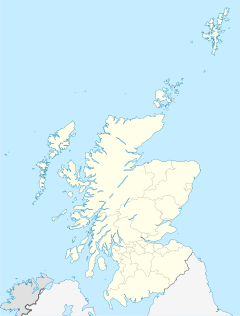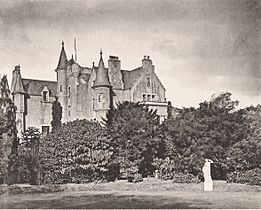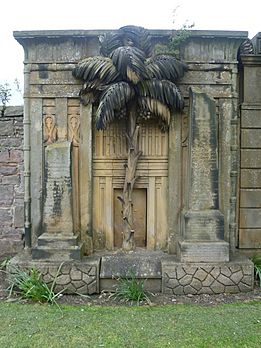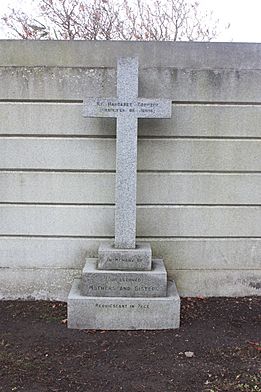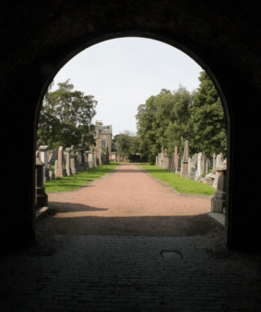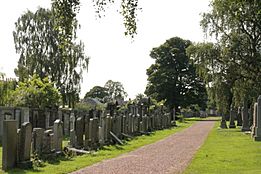The Grange, Edinburgh facts for kids
Quick facts for kids The Grange |
|
|---|---|
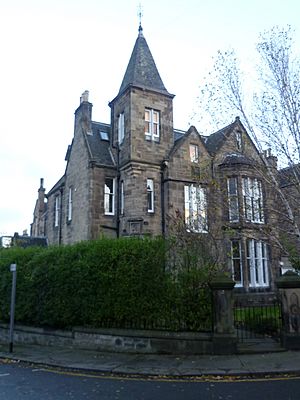 Villa in The Grange |
|
| OS grid reference | NT260716 |
| Council area |
|
| Lieutenancy area |
|
| Country | Scotland |
| Sovereign state | United Kingdom |
| Post town | EDINBURGH |
| Postcode district | EH9 |
| Dialling code | 0131 |
| Ambulance | Scottish |
| EU Parliament | Scotland |
| UK Parliament |
|
| Scottish Parliament |
|
The Grange is a fancy neighborhood in Edinburgh, Scotland. It's just south of the city center. To its west are Morningside and Greenhill. To the east is Newington. North of it are The Meadows park and Marchmont, and to the south is Blackford Hill.
The Grange is a special area protected for its history. It's known for its big, old Victorian houses made of stone, often with huge gardens. Most of The Grange was built between 1830 and 1890. People wanted to feel like they were living in the countryside, even though they were close to the city. Some streets here have very expensive homes. It's where many wealthy people, lawyers, and business leaders in Scotland live. In 2021, Whitehouse Terrace was even named one of the most expensive places to live!
Contents
Discover The Grange's Unique Style
The look of The Grange, with its buildings and green spaces, was inspired by a style called 'picturesque'. This meant buildings were designed to look unique and romantic. The houses are surrounded by lots of old trees, big gardens, and stone walls. This makes the area feel very green and open.
All the buildings use local materials, like grey sandstone. This stone is often carved with cool designs. They also use Scots slates for roofs and wooden windows. This helps the whole area look unified and special.
The Grange started to grow around 1830. At that time, many middle-class merchants and professionals in Edinburgh wanted a quiet place to raise their families. The Grange was perfect because it was separate from the busy, old city. It offered individual houses with private gardens, unlike the shared buildings in the New Town. Each house had its own fashionable Victorian style. The high quality of these homes was thanks to the Dick Lauder family, who made sure the architects met high standards.
Who Owned The Grange?
The area was first known as 'Sanct-Geill-Grange'. It was church land connected to St. Giles Cathedral in Edinburgh. King David and King Edgar mentioned it in old documents. The word 'grange' usually means a large farm with a main house.
On June 16, 1376, King Robert II gave control of St Giles' Grange to his oldest son, John, Earl of Carrick. Later, in 1391, the Wardlaw family took over the estate.
In 1506, John Cant, a businessman from Edinburgh, and his wife Agnes Carkettle, became the owners. In 1517, they gave about 18 acres (7.3 hectares) of land to the nuns of St. Catherine of Siena. In 1691, John Cant sold all of St Giles' Grange to William Dick. The 18 acres that belonged to the nuns were then owned by Sir John Napier, who invented logarithms. In 1731, when Isabel Dick, the heiress, married Sir Andrew Lauder, 5th Baronet, The Grange became part of his family's property.
Exploring Grange House
The original main house, called Grange House, was very old, possibly from the 1200s. It had two towers and a roof with battlements, like a castle. It stood alone at the eastern edge of the Burgh Muir, which was then mostly empty moorland stretching south to the Braid Hills and east to St. Leonard's Crags.
The mansion was made bigger over many centuries. Sir Thomas Dick Lauder did a major restoration. On May 16, 1836, Lord Cockburn wrote in his diary about seeing a solar eclipse from the top of the tower at Grange House with Sir Thomas and his family.
After Sir Thomas died in 1848, the house slowly fell apart. By the 1930s, it was too expensive to fix. Even though many people protested, the house was torn down in 1936. New houses and bungalows were built on part of the land, which is now Grange Crescent.
Stone statues of wyverns (dragon-like creatures) from the old gateposts, known as the 'Lauder griffins', were moved to Grange Loan. One was placed at the entrance to Lover's Loan, an old path that was kept when the area was redeveloped in the late 1800s. This path has high stone walls and borders the Grange Cemetery. Many famous people are buried there, including Sir Thomas Dick Lauder, Hugh Miller, and Thomas Chalmers.
How The City Grew into The Grange
In 1825, Thomas Dick Lauder, who owned The Grange at the time, sold a large piece of land for new buildings. This area was between what are now Dick Place and Grange Road. This sale also created a new road to the east, now called Newington Road. Lauder had strict rules for how the land could be developed, and he had to approve all building plans. The original plans even had funny names for plots of land, like Little Transylvania and Greater Transylvania! Grange House itself stayed on a large plot in the middle of Grange Loan.
From the 1840s, The Grange grew into an early suburb. It was built slowly on the lands of The Grange estate, which was still owned by the Dick Lauder family. The architect David Cousin first planned the area. Later, the plans were changed (in 1858) and greatly expanded south (in 1877) by the architect Robert Reid Raeburn.
Some of the Victorian houses still have very old trees and gardens that were there before the houses were built. In 1835, Earl Grey (famous for the Reform Bill) visited Sir Thomas Dick Lauder at Grange House. To remember his visit, he planted an oak tree in a noticeable spot in The Avenue. It was called 'Earl Grey's Oak' and was still healthy in 1898. We don't know if it's still there today.
The campus of the Astley Ainslie Hospital is also in this area. This large piece of land was given for the hospital in 1921 by John Ainslie in his will. The grounds of the Carlton Cricket Club are the last remaining large open space that used to surround Grange House.
Visiting Grange Cemetery
This cemetery was designed in 1847 by Edinburgh architect David Bryce. It has a more straight-line layout compared to older cemeteries like Warriston Cemetery and Dean Cemetery. It was originally called the Southern Edinburgh Cemetery.
You can find many interesting sculptures here. For example, there's an "Egyptian portal" for William Stuart's wife (died 1868) on the north wall, made by sculptor Robert Thomson. You can also see sculptures by William Birnie Rhind and Henry Snell Gamley. There are also many fancy Celtic crosses, mostly by Stewart McGlashan. The graves of Isabella Russell and Margaret McNicoll were designed by Robert Lorimer in 1904.
Some of the notable people buried here include:
- Thomas Chalmers, a famous church leader.
- Robin Cook, a politician who was a Labour Foreign Secretary.
- Thomas Dick Lauder, the landowner mentioned earlier.
- Hugh Miller, a pioneer geologist.
- John Hutchison (sculptor), a sculptor.
- Lady Isabel Emslie Hutton, a physician.
- Alexander Keith Johnston (1804–1871), a geographer, and his son, an African explorer.
- Christian Isobel Johnstone, an author and journalist.
- David Kennedy, a Scottish singer, and his daughter Marjory Kennedy-Fraser.
- Major Allan Ker VC, a hero from World War I.
- John Kinross, an architect.
- William McBean VC, a Victoria Cross winner.
- Charles Maclaren, who started the Scotsman newspaper.
- Thomas Nelson (publisher), a famous publisher, and his son.
- John Pringle Nichol, an astronomer, and his wife Elizabeth Pease Nichol.
- John Thomas Rochead, the architect of the Wallace Monument.
- David Watson Stevenson and William Grant Stevenson, sculptor brothers.
- Dr Norman Lang Stevenson, a cricketer and Olympic medalist.
- James Thin, who founded a famous Edinburgh bookshop.
- Andrew Usher and Sir John Usher, who were famous for whisky.
- Sir George Warrender, after whom the Warrender area is named.
- Dionysius Wielobycki, an early homeopathic doctor.
- Dame Elizabeth Blackadder, a famous artist.
The cemetery also has war graves for 40 Commonwealth service members from both World Wars. There's also a shared grave for the nuns of St Margaret's Convent.
Famous People Who Lived Here
The Grange has been home to many interesting people:
- Oil tycoon Sir Bill Gammell, a friend of Tony Blair and who had George W Bush as a wedding guest, bought property in The Grange.
- Writers like Alexander McCall Smith and Ian Rankin have lived here.
- Max Born, a Nobel Prize winner in Physics, lived at 84 Grange Loan. He was a professor at the University of Edinburgh and helped create quantum mechanics.
- Marc-André Raffalovich, a wealthy French poet and writer, lived at 9 Whitehouse Terrace. He was known for supporting the arts and for his close friendship with the poet John Gray, who also lived nearby.
- Francis H. Underwood, an American editor and writer who helped start The Atlantic Monthly magazine, lived at 35 Mansionhouse Road.
- William Henry Goold, a Scottish minister, lived at 28 Mansionhouse Road.
- David Patrick (writer), a Scottish writer and editor who worked on famous encyclopedias, lived at 20 Mansionhouse Road.
- George Smeaton, a Scottish theologian and Greek scholar, lived at 13 South Mansionhouse Road.
- John Duns (minister), a professor of Natural Science and author, lived at 4 North Mansionhouse Road.
- Thomas Smith (missionary), a Scottish missionary and mathematician who helped start missions in India, lived at 10 Mansionhouse Road.
- Frederick Hallard, a Scottish lawyer and author, lived at 7 Whitehouse Terrace.
- Dame Elizabeth Blackadder, a famous artist, lived in Fountainhall Road with her husband John Houston from the 1950s until her death in 2021.
The Grange in Pop Culture
The Grange was a main filming spot for the BBC Three comedy drama Pramface. The show used The Grange to pretend it was a fancy neighborhood in North London because the areas looked similar.


